A randomised, prospective study comparing trabeculectomy augmented with antimetabolites with a viscocanalostomy technique for the management of open angle glaucoma uncontrolled by medical therapy
- PMID: 12084743
- PMCID: PMC1771200
- DOI: 10.1136/bjo.86.7.748
A randomised, prospective study comparing trabeculectomy augmented with antimetabolites with a viscocanalostomy technique for the management of open angle glaucoma uncontrolled by medical therapy
Abstract
Aims: To compare trabeculectomy with viscocanalostomy for the control of intraocular pressure (IOP) in open angle glaucoma (OAG) uncontrolled by medical therapy.
Methods: 48 patients (50 eyes) with uncontrolled OAG were randomised to either trabeculectomy (25 eyes) or a viscocanalostomy technique (25 eyes). Preoperatively, eyes were graded in terms of risk factors for drainage failure. Those undergoing trabeculectomy were given intraoperative antimetabolites (5-fluorouracil 25 mg/ml (5-FU), mitomycin C (MMC) 0.2 mg/ml and 0.4 mg/ml) according to a standard protocol. Antimetabolites were not used intraoperatively in eyes undergoing viscocanalostomy, but they were randomised to the use of viscoelastic (Healonid GV) for intraoperative intracanalicular injection.
Results: There were no significant differences between the groups in age, sex, type of OAG, preoperative medications, risk factors for drainage failure, and preoperative IOP. Mean follow up was 19 months (range 6-24 months). It was 12 months or longer in all eyes, except one lost to follow up at 6 months. At 12 months, complete success (IOP <21 mm Hg without antiglaucoma medications) was seen in all eyes undergoing trabeculectomy (100%), but in only 64% of eyes undergoing viscocanalostomy (p<0.001). The mean IOP was lower at 12 months (p<0.001) with trabeculectomy and the number of eyes with IOPs of 15 mm Hg or less was greater (p<0.05). The mean IOP at 12 months was lower in eyes that had undergone viscocanalostomy using intraoperative intracanalicular Healonid GV injection compared to those where only balanced saline solution had been used (p<0.01). However, in terms of complete success there was no difference between the viscocanalostomy groups (p<0.1). With the exception of measurements at 1 week, visual recovery (logMAR acuity) was similar and laser flare and cell values showed little differences between the groups. Corneal topography and keratometry at 12 months were little different from preoperative values. Postoperative interventions (subconjunctival 5-FU and needling procedures) were similar between the groups. Transient complications such as early bleb leak and hyphaema were more common in the trabeculectomy group (p<0.05). Postoperative cataract formation was more common after trabeculectomy (p<0.05).
Conclusions: IOP control appears to be better with trabeculectomy. Viscocanalostomy is associated with fewer postoperative complications, although significant complications permanently impairing vision did not occur with either technique.
Figures






Comment in
-
Surgery for glaucoma in the 21st century.Br J Ophthalmol. 2002 Jul;86(7):710-1. doi: 10.1136/bjo.86.7.710. Br J Ophthalmol. 2002. PMID: 12084733 Free PMC article. No abstract available.
-
Trabeculectomy augmented with antimetabolites with a viscocanalostomy technique for the management of open angle glaucoma.Br J Ophthalmol. 2003 Mar;87(3):374-5. doi: 10.1136/bjo.87.3.374-a. Br J Ophthalmol. 2003. PMID: 12598471 Free PMC article. No abstract available.
-
Surgery for glaucoma.Br J Ophthalmol. 2003 Apr;87(4):517. doi: 10.1136/bjo.87.4.517. Br J Ophthalmol. 2003. PMID: 12642338 Free PMC article. No abstract available.
Similar articles
-
A randomised, prospective study comparing trabeculectomy with viscocanalostomy with adjunctive antimetabolite usage for the management of open angle glaucoma uncontrolled by medical therapy.Br J Ophthalmol. 2004 Aug;88(8):1012-7. doi: 10.1136/bjo.2003.037432. Br J Ophthalmol. 2004. PMID: 15258016 Free PMC article. Clinical Trial.
-
Delayed post-operative use of 5-fluorouracil as an adjunct in medically uncontrolled open angle glaucoma.Eye (Lond). 1998;12 ( Pt 4):701-6. doi: 10.1038/eye.1998.172. Eye (Lond). 1998. PMID: 9850268 Clinical Trial.
-
A comparison of the intraocular pressure-lowering effect and safety of viscocanalostomy and trabeculectomy with mitomycin C in bilateral open-angle glaucoma.Graefes Arch Clin Exp Ophthalmol. 2003 May;241(5):359-66. doi: 10.1007/s00417-003-0652-6. Epub 2003 Apr 16. Graefes Arch Clin Exp Ophthalmol. 2003. PMID: 12698257 Clinical Trial.
-
Trabeculectomy with intraoperative sponge 5-fluorouracil.Ophthalmology. 1996 Jun;103(6):963-70. doi: 10.1016/s0161-6420(96)30578-2. Ophthalmology. 1996. PMID: 8643256 Review.
-
Mitomycin C primary trabeculectomy in primary glaucoma of white patients.J Glaucoma. 1997 Oct;6(5):293-7. J Glaucoma. 1997. PMID: 9327347 Review.
Cited by
-
Trabeculectomy augmented with antimetabolites with a viscocanalostomy technique for the management of open angle glaucoma.Br J Ophthalmol. 2003 Mar;87(3):374-5. doi: 10.1136/bjo.87.3.374-a. Br J Ophthalmol. 2003. PMID: 12598471 Free PMC article. No abstract available.
-
Long term effect on IOP of a stainless steel glaucoma drainage implant (Ex-PRESS) in combined surgery with phacoemulsification.Br J Ophthalmol. 2005 Apr;89(4):425-9. doi: 10.1136/bjo.2004.058032. Br J Ophthalmol. 2005. PMID: 15774918 Free PMC article. Clinical Trial.
-
Comparison of anterior chamber flare among different glaucoma surgeries.Clin Ophthalmol. 2019 Aug 22;13:1609-1612. doi: 10.2147/OPTH.S219715. eCollection 2019. Clin Ophthalmol. 2019. PMID: 31686774 Free PMC article.
-
Clinical options for the reduction of elevated intraocular pressure.Ophthalmol Eye Dis. 2012 Apr 30;4:43-64. doi: 10.4137/OED.S4909. Print 2012. Ophthalmol Eye Dis. 2012. PMID: 23650457 Free PMC article.
-
Surgery for glaucoma.Br J Ophthalmol. 2003 Apr;87(4):517. doi: 10.1136/bjo.87.4.517. Br J Ophthalmol. 2003. PMID: 12642338 Free PMC article. No abstract available.
References
-
- Sugar HS. Experimental trabeculectomy in glaucoma. Am J Ophthalmol 1961;51:623.
-
- Cairns JE. Trabeculectomy. Preliminary report of a new method. Am J Ophthalmol 1968;66:673–9. - PubMed
-
- Cairns JE. Surgical treatment of primary open-angle glaucoma. Trans Ophthalmol Soc UK 1972;92:745–56. - PubMed
-
- Watson PG, Barrett F. Effectiveness of trabeculectomy in glaucoma. Am J Ophthalmol 1975;79:831–45. - PubMed
Publication types
MeSH terms
Substances
LinkOut - more resources
Full Text Sources
